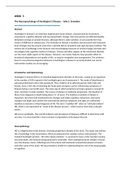WEEK 5
The Neuropsychology of Huntington’s Disease – Julie S. Snowden
https://academic-oup-com.proxy-ub.rug.nl/acn/article/32/7/876/4161107?searchresult=1
Abstract
Huntington’s disease is an inherited, degenerative brain disease, characterized by involuntary
movements, cognitive disorder and neuropsychiatric change. Men and women are affected equally.
Symptoms emerge at around 40 years, although there is wide variation. A rare juvenile form has
onset in childhood or adolescence. The evolution of disease is insidious and structural and functional
brain changes may be present more than a decade before symptoms and signs become manifest. The
earliest site of pathology is the striatum and neuroimaging measures of striatal change correlate with
neurological and cognitive markers of disease. Chorea and other aspects of the movement disorder
are the most visible aspect of the disease. However, non-motor features have greatest affect on
functional independence and quality of life, so require recognition and management. The evidence-
base for non-pharmacological treatments in Huntington’s disease is currently limited, but recent
intervention studies are encouraging.
Introduction and Epidemiology
Huntington’s disease (HD) is an inherited degenerative disorder of the brain, caused by an expansion
in the number of CAG repeats in the huntingtin gene on chromosome 4. The mode of inheritance is
autosomal dominant and is fully penetrant. Thus, children of an affected parent, both male and
female, have a 50% risk of inheriting the faulty gene and gene carriers will develop symptoms of
disease during a normal life span. The mean age at which symptoms and signs appear is around 40
years, but there is wide variation. The course of disease is insidiously progressive, the duration of
illness from diagnosis to death being about 15–20 years. The insidious evolution of disease is
important. Structural and functional brain changes and subtle cognitive, behavioral, and motor
changes may begin years before the characteristic physical symptoms and signs are sufficiently
manifest to warrant a clinical diagnosis of HD. The term “manifest HD” refers to “clinically evident”
HD, which is not equivalent to “onset of the disease process”, which may be more than a decade
earlier.
HD occurs worldwide. The overall incidence and prevalence of disease is difficult to determine with
accuracy. It is clear that HD is most common in populations of European descent.
Neuropathology
HD is a degenerative brain disease, involving progressive atrophy of the brain. The major and earliest
site of pathology is the neostriatum, which encompasses the caudate nucleus and putamen. The
mutated huntingtin protein—the CAG repeat mutation—is assumed to have a toxic function causing
neuronal death, the striatum being particularly vulnerable. More widespread brain atrophy is found
over the disease course, reflecting loss of structural and functional connectivity between striatum
and other parts of the brain. HD has provided a model for understanding the role of the basal ganglia
in cognition.
, Clinical Characteristics
HD gives rise to a triad of clinical features: motor, cognitive, and neuropsychiatric. The movement
disorder is distinctive and is the hallmark of the disease. The most characteristic feature is chorea,
rapid involuntary movements of the face, trunk, and limbs. People with HD also show dystonia, slow
twisting movements of the limbs, as well as bradykinesia, slowed execution of movements, and limb
rigidity, akin to that seen in Parkinson’s disease. These different motor features may co-occur, albeit
with variable prominence in different individuals. Notably, juvenile HD is more often associated with
prominent bradykinesia than with chorea.
Affected individuals report chorea to be less of a problem than do their caregivers and studies have
consistently shown reduced awareness of chorea in people with HD.
The cognitive and neuropsychiatric characteristics of disease are less immediately evident but their
recognition is crucial. They contribute greatly to the affected person’s loss of functional
independence and they have greatest impact on families.
Neuropsychological Features
The salient changes in HD are in the domains of psychomotor and executive skills, memory, emotion
processing, and social cognition.
Psychomotor Slowing
The earliest change and best predictor of disease progression is psychomotor slowing. Slowing is
demonstrated most commonly on timed tasks such as Stroop, Digit symbol substitution and Trail
making. Cognitive slowing is found in the “pre-manifest” stages of HD and is reported to be a
significant predictor of functional capacity in daily life. Psychomotor slowing has considerable
practical impact in daily life. It has been found, for example, to be a significant predictor of driving
cessation.
Executive Skills
Executive difficulties in HD include problems in planning, organization and sequencing, cognitive
flexibility and set shifting. In early studies, the Wisconsin Card Sorting test was commonly used to
measure cognitive flexibility. People with HD commonly also show reduced performance on verbal
fluency tasks.
A common practical difficulty observed in HD is in multi-tasking. In keeping with this, there is
neuropsychological evidence of problems in attention. Ostensibly “automatic” tasks (e.g., driving)
require more conscious attention in people with HD.
Memory
Memory difficulties are commonly reported in HD and may be noticed by the affected person as well
as by their relatives. Memory studies have shown proportionally poorer free recall than recognition
memory and cued recall, more passive learning strategies in HD than controls, problems in source
memory and in prospective memory, and relative preservation of retention form immediate to
delayed recall. The profile of memory disturbances suggests a strong executive contribution to
memory failures, in keeping with disruption to striatal-frontal pathways.






